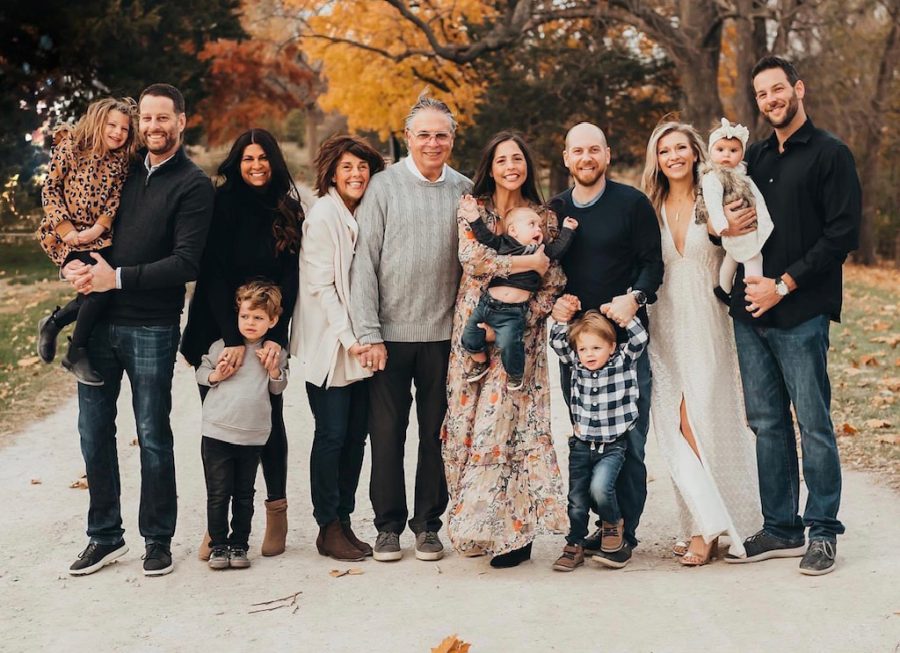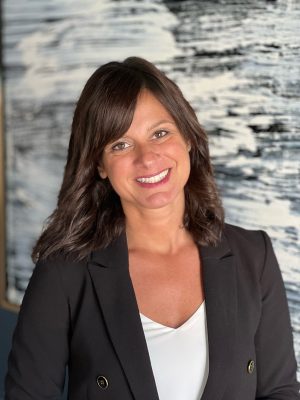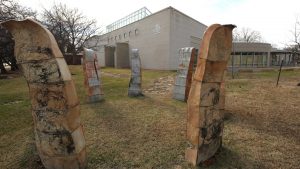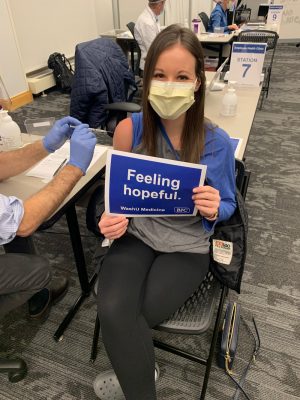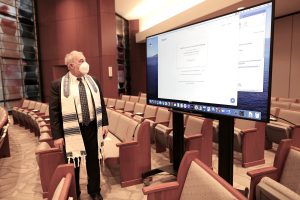How the Weinhaus family found a new normal, 2 years after COVID
Mike and Jane Weinhaus are flanked by their extended family. The couple, along with their two adult sons and one of their son’s wives, were among the first St. Louisans to contract the virus in March 2020. Both Michael and Jane were hospitalized; she spent nine days on a ventilator.
Published March 8, 2022
About a year ago, Mike Weinhaus was on the phone with a representative from his insurance company when the person asked, “Are you the family that was on the news with COVID?”
Weinhaus, a member of Congregation Shaare Emeth, was indeed part of the family that attracted international attention because in March 2020, he and his wife, Jane, were among the first people to became severely ill from the virus. They both ended up at Missouri Baptist Hospital — Jane on a ventilator — and their sons, Jason and Ryan, and Ryan’s wife, Brittanie, also became sick with the virus, too.
The insurance representative lived in Newfoundland, Canada and said, “If it wasn’t for your story, our small town would not have taken this seriously.”
Unfortunately, there have since been plenty of other examples of people becoming sick from the virus.
People in the St. Louis Jewish community have also, of course, not been immune from the pandemic’s effects, which include sickness; death; disconnection from family, friends and communal organizations; and added strain on mental health.
Still, two years after the World Health Organization declared the virus a pandemic, the number of COVID cases, hospitalizations and deaths are in decline, and governments are lifting masking requirements, among other restrictions. As such, some local Jews are again gathering in person and able to more easily find comfort and meaning in religious life.
“The restrictions on the number of attendees at a graveside service or tents not being able to be put up because of COVID or everyone being required to wear a mask or the need for private services or limited attendance — that has been hard for everyone, whether we are working with someone whose (loved one) has passed away from COVID or not,” said Emily MacDonald, manager of Berger Memorial Chapel, a Jewish funeral home. “But I do think with some of these restrictions being lifted, that will bring comfort to families and allow them to adhere to the traditions that we are used to.”
After Jane Weinhaus’ 20-day hospital stay and her husband’s 10-day stint, the two returned to their home in Chesterfield. Mike Weinhaus remained on oxygen. Jane did not but spent three weeks working with a physical therapist at home.
While her recovery happened quickly, Jane said she experienced “survivor’s guilt.”
“When you are looking at body bags in New York in the hospitals, you go through different emotions,” said Jane who, like her husband, is 65 years old.
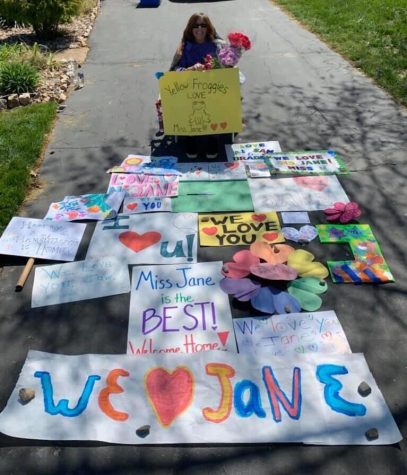
That fall, Jane returned to teaching at Temple Israel, where she has worked for more than 25 years and teaches 2-year-olds. She said she now gets even more satisfaction from her job.
“You want them to have some happy memories, whether it’s doing bubbles or the parachute or reading a book or doing an art project,” she said.
Not everything is the same though. Before the pandemic, on Fridays around lunchtime, the entire school would gather in the sanctuary, and the kids would sing and dance to celebrate Shabbat. Now teachers do it in their individual classrooms.
Jane said she looks forward to the day when the entire school is again able to gather.
It took longer for Mike Weinhaus to recover. He spent a month on oxygen at home. Then a couple more months passed before “I had enough energy to do things,” he said.
But he returned to officiating golf tournaments on a limited basis last year and plans to take on a full schedule this year.
“It’s just my passion. I just love being around the golf course every day,” he said.
He still can’t taste much though, and his sense of smell hasn’t fully recovered either.
But “we have no complains that this happened to us,” he said.
“Grateful,” Jane added.
“We don’t have any gripes,” said Mike. “We are just very fortunate people.”
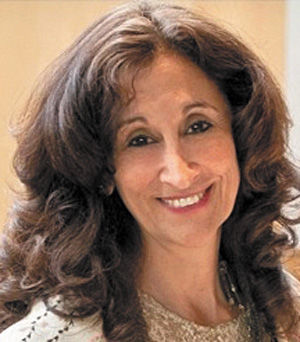
Support group provides ‘silver lining’ during pandemic
During the pandemic, No Shanda, No Shame not only switched from an in-person to a virtual format, but the Jewish support group for people struggling with mental health challenges also started to meet weekly rather than monthly.
“Because of COVID, we said, ‘We’ve got to meet weekly. There is just too much going on, and it’s just too difficult,’” recalled Rabbi Susan Talve, who leads the group along with her husband and fellow Central Reform Congregation rabbi, James Stone Goodman. “We didn’t want to lose touch with people.”
The group meets over Zoom on Sundays at 1 p.m. and opens with a teaching, usually about the week’s Torah portion.
“Every week there is a message from Torah that seems to be so relevant,” said Talve.
While the isolation caused by social distancing during the pandemic was startling for much of the population, for people with mental illness, “isolating at home is nothing new,” said Talve.
“It’s been almost a comfort for people, but it’s also not always the healthiest of things,” she said. “For people who might be more comfortable… going dark and staying by themselves, this is a safe way for people to connect with each other.”
About 20 people, most, but not all, Jewish, attend a typical meeting. Some are people with mental illness. Others are their family members. The issues that participants struggled with throughout the pandemic were often the same as before March 2020, Talve said.
“We are talking about people who lived with these diagnoses before the pandemic and will live with these diagnoses after the pandemic,” said Talve. “This pandemic has made it challenging, and our No Shandah group has been one of the lifelines for people.”
Laura Lieber and her husband, Greg, attend the meeting each week.
Laura, who works in cosmetics, has bipolar and panic disorders and anxiety and depression and was hospitalized months before the pandemic because “she was so caught up in stuff that she was not able to process and deal with her mental illness, and it was kind of a breakdown, and she needed the break,” explained Greg, who, like his wife, is Jewish.
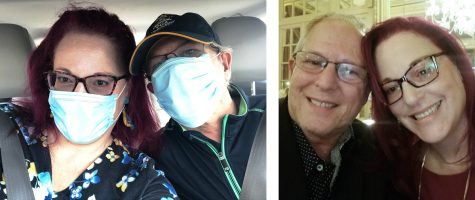
The couple, who live in west St. Louis County, started to attend No Shandah when it met monthly at the Jewish Community Center near Creve Coeur.
“I felt like I had no support system for mental illness in the community, so I was very much wanting some kind of support,” said Laura, 54, who is a mother of three.
She thinks there has been a greater need for a group like No Shandah during the pandemic.
“People in the group wait for Sunday because they know that they are going to be able to bring whatever is going on in their life to this group and get feedback and support,” said Laura.
Greg, a musician and communications sales consultant, also attends three groups for people in recovery from drug and alcohol addiction each week, including ones led by Goodman. He thinks the groups are effective — even in the virtual format.
“This pandemic has created a situation where it’s beneficial for people to be able to have that more regular interfacing, even if it’s on a screen, than not having it,” said Greg, a pianist who has been sober for four years and can now play music in bars and not be tempted to drink. “It’s pretty much a miracle that that has happened. I chalk that up to both the involvement in the” meetings “and my higher power.”
Talve said she hopes the group can again meet in person, but they have no immediate plans to do so.
Greg said he sees No Shandah as one of the silver linings of the pandemic.
“People have started helping people,” said Laura.
Greg added, “I think it’s at least become apparent that that needs to happen.”
Slow return to normalcy
MacDonald, of Berger Memorial, saw significant increases in the number of people who died from COVID in late 2020 and early 2021, before the vaccines became widely available, which followed national trends.
Families not only often had to have small, private services but also couldn’t have shiva gatherings.
“That I heard from families was really difficult to get used to,” MacDonald said.
In fall 2021, MacDonald started to see families again hold larger services and shiva gatherings.
“I am really grateful that the number of cases are declining so that if families experience a loss, they are able to celebrate or memorialize someone the way they want to, rather than a way that is dictated to them,” she said.
Craig Roth, vice president and funeral director of Rindskopf-Roth Funeral Chapel, also recently saw an increase in the number of shivas open to the community, as well as more people again shaking hands and hugging.
“I do think there is a slow return to normalcy, and I do think people are able to get more comfort and consolation today than they were a year ago,” said Roth.
Still, whether it’s a funeral at the grave site or service in a chapel, Roth said he continues to notice one change: there are fewer older adult attendees than before the pandemic.
“They might want to come” but “are still very cautious about contracting the virus because of their age or because of underlying health concerns,” said Roth. “That is the kind of thing that I don’t know we will ever see go away.”



